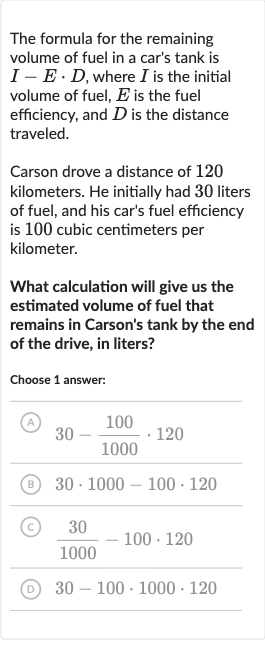AI tutor
Welcome to Bytelearn!
Let’s check out your problem:

The formula for the remaining volume of fuel in a car's tank is , where is the initial volume of fuel, is the fuel efficiency, and is the distance traveled.Carson drove a distance of kilometers. He initially had liters of fuel, and his car's fuel efficiency is cubic centimeters per kilometer.What calculation will give us the estimated volume of fuel that remains in Carson's tank by the end of the drive, in liters?Choose answer:(A) (B) (C) (D)
Full solution
Q. The formula for the remaining volume of fuel in a car's tank is , where is the initial volume of fuel, is the fuel efficiency, and is the distance traveled.Carson drove a distance of kilometers. He initially had liters of fuel, and his car's fuel efficiency is cubic centimeters per kilometer.What calculation will give us the estimated volume of fuel that remains in Carson's tank by the end of the drive, in liters?Choose answer:(A) (B) (C) (D)
- Understand Problem: Understanding the problem and identifying the correct formula to use.The problem gives us the formula for calculating the remaining volume of fuel in a car's tank, which is . Here, is the initial volume of fuel, is the fuel efficiency (in cubic centimeters per kilometer), and is the distance traveled (in kilometers). We need to find the correct calculation that represents the remaining volume of fuel in Carson's tank, in liters, after driving a distance of kilometers with an initial fuel volume of liters and a fuel efficiency of cubic centimeters per kilometer.
- Convert Units: Converting the given values to a consistent unit.Since the fuel efficiency is given in cubic centimeters per kilometer, and the initial volume of fuel is in liters, we need to remember that liter cubic centimeters. This conversion is crucial for maintaining consistency in units throughout the calculation.
- Identify Correct Option: Identifying the correct option based on the formula and unit conversion.The formula requires us to subtract the product of fuel efficiency () and distance () from the initial volume of fuel (). Since is in cubic centimeters per kilometer and is in liters, we need to ensure that the units are consistent. Option (A) correctly applies the formula and accounts for the unit conversion by dividing the product of and by to convert cubic centimeters to liters. This is the correct approach to find the remaining volume of fuel in liters.
More problems from Interpret parts of quadratic expressions: word problems
QuestionGet tutor help
QuestionGet tutor help
QuestionGet tutor help
QuestionGet tutor help
QuestionGet tutor help
QuestionGet tutor help
QuestionGet tutor help
QuestionGet tutor help
